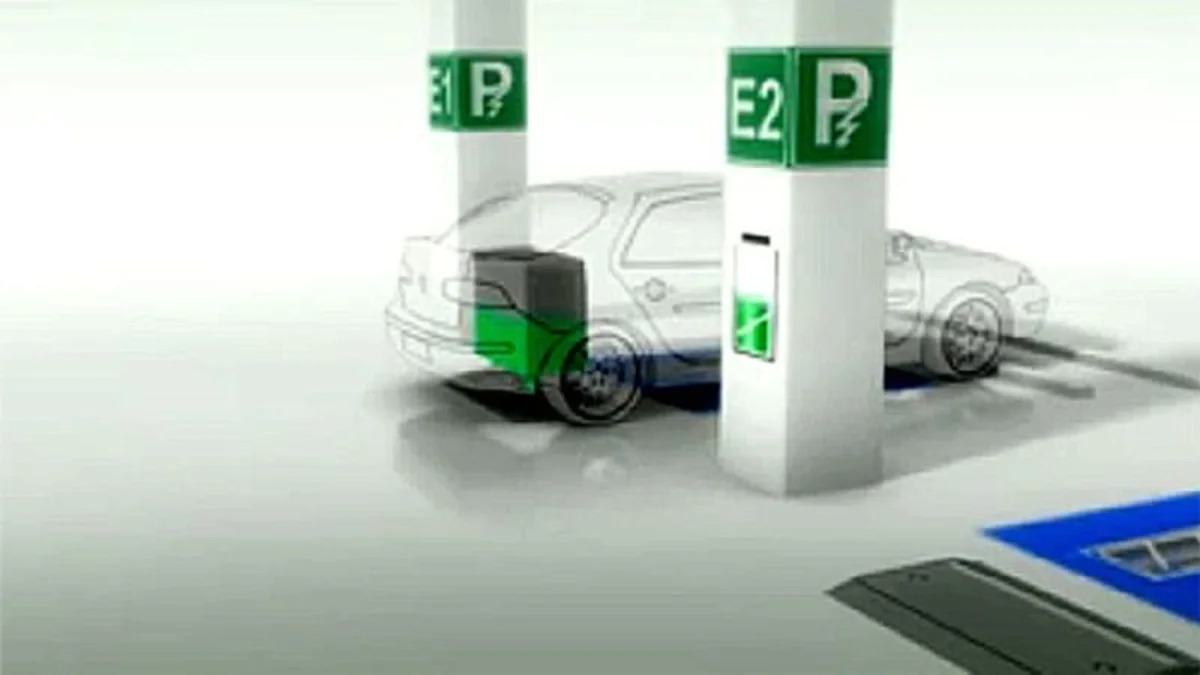As electric vehicles (EVs) slowly emerge back into the transportation picture after 100 years of semi-hibernation, consumers may be faced with a paradigm quite different from the regular visits to the gas station most are used to.  The three leading new options to re-supply our autos with energy are charging at home, battery swap stations and fast charge stations. There are proponents of each method and, though all three could be used, it is possible that one or more might never make it in the real world or that another method might come to the fore. We'll take a look at these three different energy resupply methods and outline some of their strengths as well as weaknesses. Hit the jump for a comparison that includes plenty of pics and video.
The three leading new options to re-supply our autos with energy are charging at home, battery swap stations and fast charge stations. There are proponents of each method and, though all three could be used, it is possible that one or more might never make it in the real world or that another method might come to the fore. We'll take a look at these three different energy resupply methods and outline some of their strengths as well as weaknesses. Hit the jump for a comparison that includes plenty of pics and video.
The method that should seem most natural is charging at home. Just as we have become accustomed to plugging in our cell phones everyday, the habit of plugging in your car after returning home could easily become second nature. There are likely many benefits to home charging that ought to make this the most popular option and here we'll cover the three "c"s: convenience, cost, and carbon-control.
There's no questioning the convenience of never having to stop by an energy station to "fill up" before heading off on a busy day about town. It eliminates waiting in lines or out of order machinery and gives you the benefit of your vehicle's full range right from your doorstep. The only time involved is the few seconds it takes to plug in and later, unplug, your car and possibly press a button.
If cost is an important consideration, than charging your EV at home is a no-brainer as it cuts out any profit-hungry middlemen. Also, besides giving you the ability to charge at night when most utility rates are lower, future vehicle-to-grid (V2G) technology may allow you to sell some of your stored energy back to the utilities.
Many future owners may be driving EVs in an effort to reduce their carbon footprint and charging at home could give them the opportunity to control the source of the energy that goes into their car. For instance, they may have solar panels on their roof or could, via their utility, opt for energy from renewable sources.
Of course, everything has its drawbacks and one problem with charging at home is that it is not an option available for some city dwellers. Although charging infrastructure is beginning to find its way into cities, it may be awhile until they are available in residential neighborhoods en masse.
 The three leading new options to re-supply our autos with energy are charging at home, battery swap stations and fast charge stations. There are proponents of each method and, though all three could be used, it is possible that one or more might never make it in the real world or that another method might come to the fore. We'll take a look at these three different energy resupply methods and outline some of their strengths as well as weaknesses. Hit the jump for a comparison that includes plenty of pics and video.
The three leading new options to re-supply our autos with energy are charging at home, battery swap stations and fast charge stations. There are proponents of each method and, though all three could be used, it is possible that one or more might never make it in the real world or that another method might come to the fore. We'll take a look at these three different energy resupply methods and outline some of their strengths as well as weaknesses. Hit the jump for a comparison that includes plenty of pics and video.
The method that should seem most natural is charging at home. Just as we have become accustomed to plugging in our cell phones everyday, the habit of plugging in your car after returning home could easily become second nature. There are likely many benefits to home charging that ought to make this the most popular option and here we'll cover the three "c"s: convenience, cost, and carbon-control.
There's no questioning the convenience of never having to stop by an energy station to "fill up" before heading off on a busy day about town. It eliminates waiting in lines or out of order machinery and gives you the benefit of your vehicle's full range right from your doorstep. The only time involved is the few seconds it takes to plug in and later, unplug, your car and possibly press a button.
If cost is an important consideration, than charging your EV at home is a no-brainer as it cuts out any profit-hungry middlemen. Also, besides giving you the ability to charge at night when most utility rates are lower, future vehicle-to-grid (V2G) technology may allow you to sell some of your stored energy back to the utilities.
Many future owners may be driving EVs in an effort to reduce their carbon footprint and charging at home could give them the opportunity to control the source of the energy that goes into their car. For instance, they may have solar panels on their roof or could, via their utility, opt for energy from renewable sources.
Of course, everything has its drawbacks and one problem with charging at home is that it is not an option available for some city dwellers. Although charging infrastructure is beginning to find its way into cities, it may be awhile until they are available in residential neighborhoods en masse.
Battery swap stations are a concept often associated with Better Place, an EV infrastructure company. The idea is that when your car needs more energy, you can drive your car into a station and, like an automated car wash, your depleted battery is replaced robotically by one that has a full charge. It is thought that the cars that Renault is building to function with the Better Place model will have the ability to have its power supply swapped and the newly announced Tesla Model S is said to also incorporate this concept. Currently, there are some industrial facilities that use battery swapping to replenish the energy stores of electric forklifts.
The main benefit associated with the swapping model is speed. The whole operation could take less than five minutes, pretty much the same amount of time many people spend filling their gas tanks at stations today. Another plus is not having to leave your car or deal with potentially tangled or dirty cords. You could sit in your vehicle while the operation takes place. Hey, maybe you got an email during the drive, right?
Battery swapping has its critics. A couple of drawbacks to consider might be the capitalization costs of building these stations and the batteries that they would have to have in stock. Some critics also point out the possible dangers of electrocution from a malfunctioning robot swap arm. Standardization of battery shape and chemistry is another consideration that gives one pause. Chrysler alone, for instance, may have 3 different battery pack shapes in its upcoming models.
The video meant to be presented here is no longer available. Sorry for the inconvenience.
Finally, there are charging stations. Giving drivers the convenience of charging their vehicles when they are away from home, charge stations have already been with us for some time and are now being installed in at a quickening pace. They offer the opportunity of adding range to your vehicle while you are working, eating or shopping. There are a growing number of companies in this field - Coulomb, Elektromotive, and Better Place (again), to name just three - and the competition should see the evolution of increasingly better equipment and electricity sources. Besides single charging points at strategic consumer locations, some companies are also developing plans for stations that offer you other services while you wait, while others are pinning their hopes on facilities with the ability to "fast charge". BYD, for examples, says their 60 mile range-extended vehicle can add 30 miles of range in ten minutes. They have several stations already built and plan on thousands more.
One of the main drawbacks to charge stations is speed. Most charge points available today take much longer to re-energize batteries than it does to fill a gas-powered car's tank. Also, until standardization of connectors becomes fully implemented, EV owners may have to carry an assortment of adapters to be able to plug in to chargers from different suppliers. Fast charging could possibly address the speed issue but that system, too, is not without its detractors. The demands on the grid would require a lot of infrastructure work without some sort of "energy reservoir" in place. Perhaps more importantly, quickly "pouring" electricity into many of the batteries available today may stress the very expensive component and shorten their useful lifetime.
Whatever the method we eventually use to charge our vehicles, it is a welcome break from the smelly dirty world of disease-causing liquid fuel. Please feel free to tell us what you believe to be the benefits of some of the various recharging modes mentioned above in the comments section below.
The video meant to be presented here is no longer available. Sorry for the inconvenience.
The video meant to be presented here is no longer available. Sorry for the inconvenience.


Sign in to post
Please sign in to leave a comment.
Continue